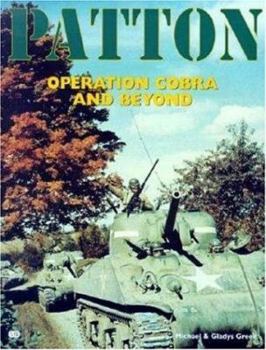Patton: Operation Cobra and Beyond
Select Format
Select Condition 
Book Overview
An account of the military actions and personal convictions of General George S. Patton following his diversionary role during the D-Day invasion. This description may be from another edition of this product.
Format:Paperback
Language:English
ISBN:076030498X
ISBN13:9780760304983
Release Date:November 1998
Publisher:Zenith Press
Length:160 Pages
Weight:1.15 lbs.
Dimensions:0.4" x 8.2" x 10.6"
Related Subjects
HistoryCustomer Reviews
2 ratings
Great Photos, Decent Overview
Published by Thriftbooks.com User , 15 years ago
This is the first of two books Mr Green has written about Normandy and later about the "Bulge". They both have the same format. I consider this book to be a good Photo Catalog with an Overview attached. The overview is good but if you have already read about the Normandy landings and the race to Paris, this book will be an extravagance for you'll learn nothing new. If you have read Patton's "War As I Knew It" or books by D'este or Blumenson then you already have a good understanding of Patton's life for 1944. The book will be a great starter book for its straightforward and easy to understand and it will wet your appetite to read more about Patton and about Normandy and the expansion of the beachhead in the early days of the invasion. The book does tell about Bradley's brainchild Operation Cobra and its deviation from Eisenhower's wide front strategy. It also tells about Patton's aggressive tank tactics and on how he influences his 3rd Army to higher levels. It touches on Marigny, Coutances, Avranches, the gateway to Brittany, after the important capture of St Lo in mid July. The author's coverage continues with Patton driving on Rennes and Forgeres and the rest of Brittany though several fortress ports held out. Leaving Brittany, the 3rd Army moves toward Alencon and then to Falaise where Patton was critical of Bradley for not allowing him to close the gap for the Canadians. Then Patton races to the Seine River. As Patton closes in on the Moselle River German resistance increases and the advance slows. The overview ends with Patton nears the Rhine River. For further reading the author offers some excellent choices in his Bibliography I would suggest having this book in your collection just for the photos; they're quite good and the overview is good also, just a little too brief tactically for me.
Excellent book.
Published by Thriftbooks.com User , 25 years ago
Michael Greene'sOperation Cobra and BeyondReview by Charles M. ProvinceAs the founder and president of The George S. Patton, Jr. Historical Society, I am obliged to purchase a copy of every "Patton book" that comes on the market, quality notwithstanding. Be it a well written or poorly written book makes no matter. Be it a pro-Patton or anti-Patton book makes no difference, either. Each and every one belongs in the Patton Society's library.I am glad to have the opportunity of acknowledging that Michael Greene's new book Patton's Dash Across France is one of the good books. It is a book I will purchase and be delighted to place into the Society's library. I heartily recommend it.Greene has taken on a very difficult job in that he has tried to squeeze the entire Third Army's World War II record into a mere thirty thousand word book. He has, however, admirably accomplished his goal.Greene's knack of understanding which of the smallest details are the most pertinent in relation to the overall "Big Picture" allows him to succinctly explicate the role of the Third Army in the overall European Theater of Operations and to untangle the complex organizational structure of Patton's Army. His explanations encompass all levels of command, from Army and Corps to Division and Battalion all the way down to company level and the infantry rifle platoon. Most people in the United States todayincluding many who have served in the military-possess very little understanding of the upper echelons of command, i.e. what commanders do and why they do it and how they accomplish the massive job of running an army. Greene has penned a book that is not only interesting to avid history buffs but one that could be used as a primer of military organization for neophyte readers.Greene gives explanations of some major problems encountered by the U.S. Army during its initial attack on the European continent. Problems other than those posed by the German Army. The matter of hedgerows comes to mind. Although hedgerows are mentioned innumerable times in many books, unless a reader has seen one, they probably don't really know what they are or what they look like. Dating from Roman times, hedgerows caused incessant and disastrous problems for the Allies both in time lost and more importantly lives lost. Ile hedgerows were easily as much a deterrent as were the Germans. Greene explains all.Patton was one of the first U.S. Army officers to fully understand and use airplanes for air cover. Greene describes the relationship between Patton's Third Army and Brigadier General Otto P. Weyland's XIX Tactical Air Command (TAC). Greene reports that when the Third and the XIX met, it was love at first sight. Patton and Weyland worked so closely together that Patton even used them for flank cover when Walton Walker's XX Corps lacked the necessary men and material to adequately cover the Loire River.For avid Patton fans the real story of Patton's Third Army sta






